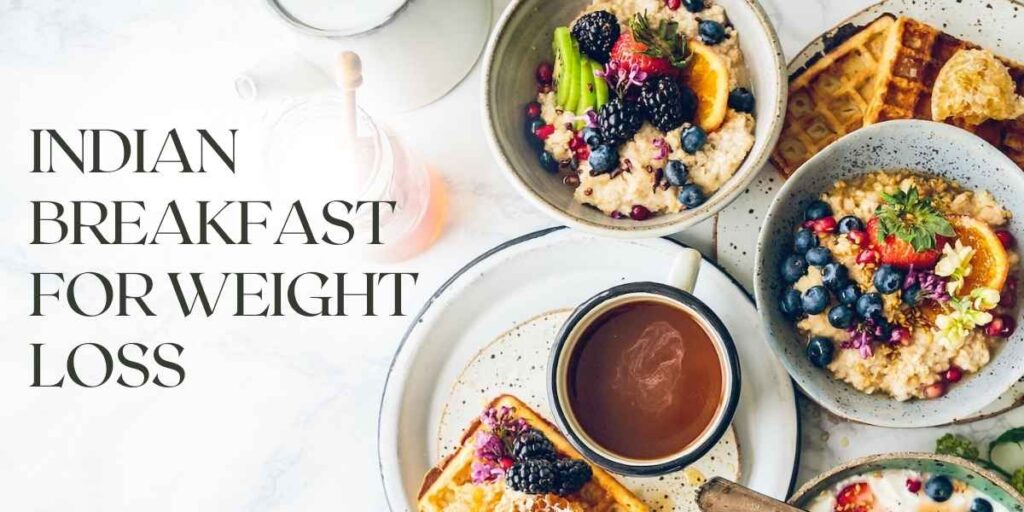Breakfast is often referred to as the most important meal of the day, especially when it comes to weight loss. A nutritious, balanced breakfast jumpstarts metabolism, curbs unhealthy cravings, and sets the tone for healthier choices throughout the day. Indian cuisine offers a wide variety of flavorful and nourishing breakfast options that can be adapted to suit weight loss goals. By choosing fiber-rich ingredients, adding lean protein sources, and using mindful cooking methods, you can craft meals that keep you energized and satisfied for hours. This blog explores the best Indian breakfasts to help you stay full, satisfied, and on track with your fitness journey, while enjoying delicious local flavors every morning.
Top 10 Indian Breakfast for Weight Loss
Here are the top 10 Indian breakfast options that are healthy, filling, and ideal for weight loss:
- Oats Upma – A fiber-rich twist on traditional upma using oats instead of semolina, making it a great choice for those watching their calorie intake.
- Moong Dal Chilla – High in protein and low in calories, perfect with mint chutney, and it helps keep mid-morning hunger at bay.
- Vegetable Dalia (Broken Wheat Porridge) – Rich in fiber and nutrients, this dish aids digestion and adds lasting fullness.
- Idli with Sambhar – Light, steamed, and protein-packed, it’s easy on the stomach and provides a boost of plant-based nutrients.
- Vegetable Poha – Made with flattened rice and vegetables, low in fat, and quickly prepared for busy mornings.
- Sprouts Salad – A raw, crunchy, and protein-rich start to your day, loaded with vitamins and minerals.
- Besan Chilla – Chickpea flour pancakes filled with veggies, offering a mix of protein and fiber to fuel your morning.
- Ragi Dosa – Made from finger millet, high in calcium and fiber, making it excellent for bone health, while being gentle on digestion.
- Fruit and Greek Yogurt Bowl – Naturally sweet and rich in probiotics, providing a refreshing and gut-friendly breakfast option.
- Multigrain Paratha (light oil) – Made with mixed flours and stuffed with veggies, it’s filling without being heavy, and perfect for an energetic start.
These options support sustained energy release and promote fat loss when combined with regular physical activity, encouraging long-term healthy habits every morning.
Related – High Protein Vegetarian Foods
South Indian Breakfast for Weight Loss
South Indian breakfasts traditionally have a higher carbohydrate content, but with a few thoughtful adjustments, they can be turned into excellent options for weight loss.
- Idli with sambhar – This combination is light yet filling and offers a good source of protein from the lentils in sambhar.
- Ragi dosa – A nutritious substitute for the regular dosa, made using finger millet, which is rich in fiber and helps keep you full longer.
- Vegetable upma (with minimal oil) – Increase the amount of vegetables for added nutrients and reduce the semolina quantity to cut down on carbs. Use oil sparingly for a healthier version.
- Steamed vegetable uthappam – Use fermented batter and cook with less oil to maintain a light and easy-to-digest meal.
- Coconut chutney in moderation – While delicious, coconut chutney is high in fat, so enjoy it sparingly to keep your fat intake in check.
These modifications make traditional South Indian breakfast items healthier without sacrificing taste or cultural authenticity, supporting a balanced approach to weight loss.
North Indian Breakfast for Weight Loss
North Indian breakfasts are generally more filling and dense, but many dishes can be modified to suit a weight-conscious diet with ease:
- Besan chilla with mint chutney – High in protein and fiber, this chickpea flour pancake is both nutritious and satisfying. Pairing it with mint chutney adds freshness without extra calories.
- Stuffed multigrain paratha (dry roasted) – Made with multigrain flour and cooked with minimal ghee, this option provides complex carbs and fiber. Serving it with low-fat curd keeps it light and aids digestion.
- Vegetable poha – Incorporate peas, carrots, and other veggies, and prepare it with minimal oil for a low-calorie but tasty breakfast.
- Missi roti with curd – Made from a mix of gram flour and whole wheat, missi roti is rich in protein and fiber. Consuming it with curd enhances protein intake and keeps you full longer.
- Moong dal sprouts salad – A no-cook, refreshing choice that’s packed with protein and fiber, perfect for a light and healthy start to your day.
These simple changes transform traditional North Indian breakfasts into wholesome, weight-loss-friendly meals without compromising on flavor or satisfaction.
Low Calorie Indian Breakfast for Weight Loss
Opting for low-calorie breakfast choices is essential for maintaining a calorie deficit while still getting the necessary nutrients to start your day right.
- Oats porridge with skim milk and fruit – This combination is both filling and heart-healthy, providing fiber and essential nutrients without excess calories.
- Plain idlis with sambhar (avoid coconut chutney) – Steamed and low in fat, idlis paired with sambhar offer a light yet satisfying meal. Skipping the coconut chutney helps reduce fat content.
- Boiled moong sprouts with lemon and salt – A refreshing, protein-packed option that’s easy to prepare and keeps you full for longer.
- Fruit bowl with chia seeds – Naturally sweet and low in calories, this bowl also provides omega-3 fatty acids and fiber thanks to chia seeds.
- Low-oil vegetable upma or poha – Prepared with minimal oil and plenty of vegetables, these dishes are light but nutrient-dense.
These breakfasts generally contain between 150 to 300 calories per serving, depending on the portion and ingredients used, making them excellent choices for weight loss and healthy living.
Weight Loss Breakfast Menu
Here’s a simple three-day breakfast idea to help with weight loss without feeling like you’re missing out:
Day 1:
- Start with oats upma. It’s hearty and keeps you full for a good while.
- Pair it with some herbal tea or black coffee—something light to wake you up.
Day 2:
- Try besan chilla with tomato chutney. The savory chickpea pancake and tangy chutney make a great combo.
- If you like, have one boiled egg on the side for a little extra protein.
Day 3:
- A bowl of fresh fruits topped with low-fat Greek yogurt works wonders—sweet and creamy without being heavy.
- Grab a small handful of almonds or walnuts to keep things satisfying.
Switching things up keeps breakfast interesting, and this mix covers protein, good carbs, and healthy fats so you won’t feel deprived while staying on track with your goals.
Conclusion
When it comes to losing weight, having a good Indian breakfast plan can really help. If you focus on eating whole grains, lean proteins, and foods high in fiber, while cutting back on too much oil and sugar, you can enjoy meals that taste great and keep you healthy. These choices don’t just help with shedding pounds—they also give you steady energy throughout the morning.
It’s important to remember that sticking to these habits over time is what really makes a difference. Watching how much you eat, being consistent with your meals, and drinking enough water go hand in hand with what you’re eating. Small changes that you can keep up every day will add up to big results in the long run.
Try to keep things simple and enjoyable—that way, it won’t feel like a chore, and you’ll be more likely to stick with it.
FAQs
Q1. Can I eat paratha while I’m trying to lose weight?
Ans:- Yes why not! Just make the parathas a bit healthier by using multigrain flour and don’t overdo the oil or butter whatever you use. Instead of heavy sides, pair it with some curd or chutney to keep things light but flavorful.
Q2. Are South Indian breakfasts good for weight loss?
Ans:- Yeah there are but the main ingredients is using the quantity of oil. There are many great options. Steamed dishes like idli and dosa are light yet filling, providing energy without feeling too heavy.
Q3. Should I skip breakfast to lose weight?
Ans:- Usually, that’s not a good choice. Skipping breakfast can leave you really hungry later on, which might make you overeat. It’s better to have a light and nutritious breakfast.
Q4. When’s the best time to have breakfast?
Ans:- Try to eat within an hour or two after waking. This helps jumpstart your metabolism and keeps your energy steady through the morning.
Q5. Can I just have tea or coffee in the morning?
Ans:- You can have aither tea or coffee, but keep things simple – avoid sugar and don’t add too much milk. Having a small snack along with your drink is a good idea too. But avoiding any tea or coffee is best. You can go for a black coffee instead.
Q6. How much should I eat for breakfast?
Ans:- Eat enough to feel satisfied but not stuffed. For most people, around 300 to 400 calories is a good guideline. Never ever eat food for taste alone as you will start stuffing food in your body.
Q7. Can I eat only fruits for breakfast?
Ans:- Occasionally, yes. But fruits alone might leave you hungry sooner than you’d like. Adding some yogurt, nuts, or seeds can help keep you full longer.







